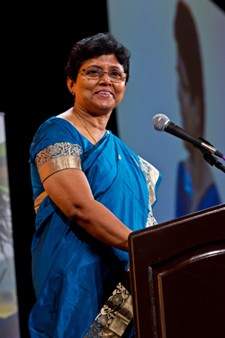 Last year, the government of West Bengal and Landesa’s partner in India, RDI, started a revolution in that Indian state by simply adding a second blank line on a piece of paper.
Last year, the government of West Bengal and Landesa’s partner in India, RDI, started a revolution in that Indian state by simply adding a second blank line on a piece of paper.
The Government of West Bengal’s anti-poverty program includes the provision of land to landless families. For years it has been the case that the “pattas” or land titles the government handed out contained a single line for the owner’s name.
And almost always this has been reserved for the head of household.
And almost always this has meant, the man.
And no one gave this much thought.
Until in our research and field work we noticed that women whose names were not on their land title were being evicted when their husbands died or even when there was a quarrel between the wife and husband. Often, in-laws would lay claim to property and show no mercy to the widow or her children, leaving them destitute and homeless.
Our research also showed that when women and men were both listed on the title, it increased women’s bargaining power in the household. It gave women more power to ensure that the profits from any home business or agriculture work on the plot went towards meeting their children’s needs – ensuring they are well fed and attend school.
So with this research, as with all of our research, we approached our partners, the Land & Land Reforms Department of West Bengal government to suggest adding a single line to all of the pattas that they distribute.
We went from one office to another explaining that all we were proposing was a small change in the format of the title. After much back and forth—the government agreed. The department issued a revised Patta format with two equally prominent lines for writing the owners’ names! And that the wife’s name would be listed first, then the husband’s.
And with this extra line on a patta, we have forever changed these families and their communities. A change that is generational, durable, and structural.
I don’t think it is too much to say that the future of India will be, in part, determined by the women whose names are now on that new line.
Thanks to this extra line on the title, both husband and wife can apply for loans to make improvements to their land or start a small business. They both have security. And their children do too.
All this from land and a pair of simple lines on a piece of paper.
You can watch a speech I gave on this topic during Landesa’s annual Seed the Change event.
For more information on Landesa’s partnership with RDI in West Bengal, click here.

Comments 3
I congratulate you for making women equal partners in landholding. It is a very important and first step towards gender equality. However we got to watch out for the true women empowerment when the following happen:
The woman participates equally with her man on all decision making regarding their land like decision on crops, agriculture inputs, marketing activities, lease decisions etc
The woman has direct access to the income generated from the economic activities on the land
The woman can claim her right on the land in case of divorce or separation from her husband
The woman can approach the judiciary in case of a land dispute..
Legal ownership of women on land is definitely a phenomenal step towards women empowerment and socioeconomic security to women. However lot of activism is required to empower the women and create the awareness on their land rights…Way to go! But definitely a great beginning!!!
Dear Swetha, you are absolutely correct. It is a long way to go and support services like legal awareness are very important.
In the meantime, it would a wonderful experience to watch on how the gender equations change with the family with this new situation of joint ownership of property. Both wife and husband will float, discuss and slowly evolve new ways of recognising each other, using and enjoying benefits and rising up to needs and challenges in life.
Gracy
Gracy, your efforts towards gender equality is quite commendable. This actually does with the land grabbing issues. What of Africa? May be we need to revise many customs and laws of the indigenous people?